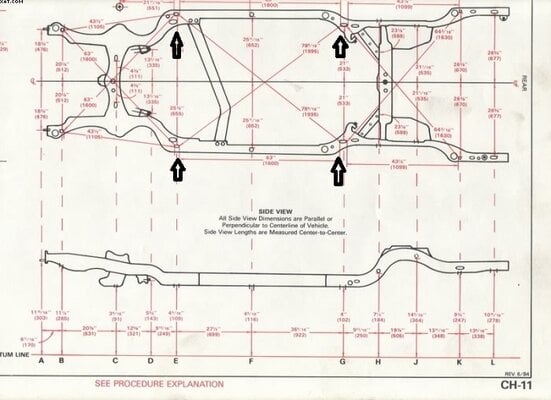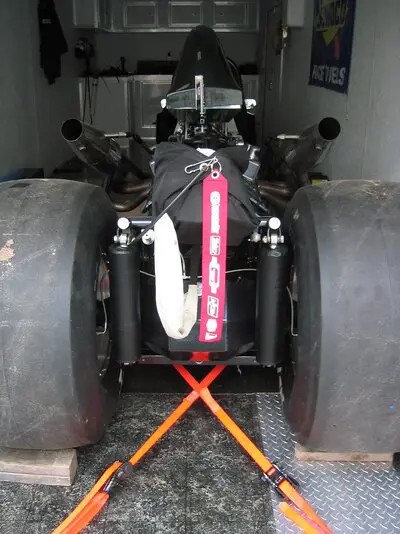I recommend using the four frame holes GM provided. Just in front of the rear wheels and just behind the front wheels are openings in the bottom of the frame where it kicks in to go up over the wheels. These openings are not quite round, and result from where the two frame rail stampings overlap a little. See image. I always use four ratchet straps and have never had a problem with using these locations. If you tie down too close to the ends of the car, you could pop off a tiedown if the car jumps up and down on the suspension over a bump in the road. That's why other posters recommend tying down to the axles or control arms - these aren't sprung.
Another detail to consider is positioning the car on the trailer deck. Recognize that the average G-body is heavier in the front than the rear. Your goal is to have the tongue load the towing vehicle with about 10% of the combined trailer/load weight. This means about 60F/40R weight distribution on the trailer. This minimizes the chance that the trailer will whip back and forth due to an unstable condition. !'ve been doing this a long time, and my idiot check is whether I can lift the tongue at all by hand when hitched to the ball. If not at all, it's too heavy on the front, move the towed car back 4-8 inches. If the tongue is actually lifting the ball, that is the most dangerous condition likely to make the trailer sway, and if you hitch fails, the rig flips up and rips out the safety chains.
Avoid going far/fast if you do not have trailer brakes. Once a trailer starts whipping back and forth, the only way to break the cycle is to slow the trailer first and 'snap' the rig out of the harmonic. If you have no trailer brakes, the only option you have is to speed up, which may work, or may end your adventure in an ugly way.
Check your trailer tire pressure. A soft tire heats up a lot when loaded. Most people ignore their trailers, leaving the tires to rot in the sun. Damaged sidewall plus low air pressure is the formula for an overheated tire and a blowout. At minimum, you then have to find a place to change a tire. If you're unlucky, you take out both tires on one side (and have one spare). If you're really unlucky, you tear up trailer fender and fling chunks into your towed car.
Another detail to consider is positioning the car on the trailer deck. Recognize that the average G-body is heavier in the front than the rear. Your goal is to have the tongue load the towing vehicle with about 10% of the combined trailer/load weight. This means about 60F/40R weight distribution on the trailer. This minimizes the chance that the trailer will whip back and forth due to an unstable condition. !'ve been doing this a long time, and my idiot check is whether I can lift the tongue at all by hand when hitched to the ball. If not at all, it's too heavy on the front, move the towed car back 4-8 inches. If the tongue is actually lifting the ball, that is the most dangerous condition likely to make the trailer sway, and if you hitch fails, the rig flips up and rips out the safety chains.
Avoid going far/fast if you do not have trailer brakes. Once a trailer starts whipping back and forth, the only way to break the cycle is to slow the trailer first and 'snap' the rig out of the harmonic. If you have no trailer brakes, the only option you have is to speed up, which may work, or may end your adventure in an ugly way.
Check your trailer tire pressure. A soft tire heats up a lot when loaded. Most people ignore their trailers, leaving the tires to rot in the sun. Damaged sidewall plus low air pressure is the formula for an overheated tire and a blowout. At minimum, you then have to find a place to change a tire. If you're unlucky, you take out both tires on one side (and have one spare). If you're really unlucky, you tear up trailer fender and fling chunks into your towed car.




